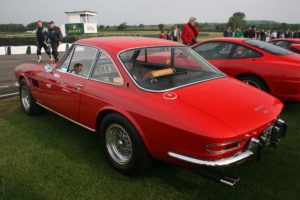The classic car experts at Hagerty® have put together the following start-up checklist. If your classic car has been sitting for a while, take the time to prep before a long drive. You’ll both be better for it.
Start with Your Battery
If your classic car has been on a trickle charger all winter, disconnect it from the charger and reconnect the battery. If you simply removed the battery and stored it in a warmer spot for the winter, it’s time to charge it up.
Check Fluids
 Start with a walk around and examine the floor beneath the car. Drips are common and expected, but puddles are not. A fresh oil change is recommended. Water or other fluids may have found their way in your crankcase. While you’re at it, replace the oil filter. Also, check your other fluids, including brakes, coolant, transmission and windshield washer. Do they look dirty? Are they at the recommended level? Smell your transmission fluid. If it smells burnt, change it.
Start with a walk around and examine the floor beneath the car. Drips are common and expected, but puddles are not. A fresh oil change is recommended. Water or other fluids may have found their way in your crankcase. While you’re at it, replace the oil filter. Also, check your other fluids, including brakes, coolant, transmission and windshield washer. Do they look dirty? Are they at the recommended level? Smell your transmission fluid. If it smells burnt, change it.
Generally speaking, if you can’t remember the last time you drained and flushed any particular fluid, it’s probably time to do it again. As for gasoline, your classic car should be good to go if you put STA-BIL in the gas tank before storing your car. If not, you might consider adding a water-absorbing product. If you’re really worried about it, drain the tank.
Check Your Belts and Hoses
 Since rubber breaks down over time, examine the condition of your tires. Make sure they’re inflated to the correct air pressure. Don’t forget about the spare, either.
Since rubber breaks down over time, examine the condition of your tires. Make sure they’re inflated to the correct air pressure. Don’t forget about the spare, either.
In addition to potentially damaging your engine, water can cause brake problems, as well. If your car has been sitting for a while, consider bleeding your brakes. They should feel firm when you push the pedal.
By this point, you should already know if any mice spent a comfortable winter in or around your engine. Check inside the passenger compartment, especially under the seats and in the glove box. Lastly, check the headlights, turn signals and brake lights. This will require a friend’s help.
Start Your Classic Car
It’s finally time to start your classic car. If you’re just testing the engine, make sure an exit door is open enough to allow exhaust fumes to escape. If the weather allows for a drive, make that first one fairly short. A half hour or so should put the car through its proper paces. Before you take drive number 2, do the ol’ walk-around again. No major leaks? Tires look good?
Want one last pro tip? Make sure you have the right Auto Insurance. Call an Insurance Specialist at (855) 919-4247 for a free quote and the lowest rates in minutes.
Then, let ’er rip and enjoy the drive.
The information in this article is obtained from various sources. This content is offered for educational purposes only and does not represent contractual agreements, nor is it intended to replace manuals or instructions provided by the manufacturer or the advice of a qualified professional. The definitions, terms and coverage in a given policy may be different than those suggested here. Such policy will be governed by the language contained therein.Â
